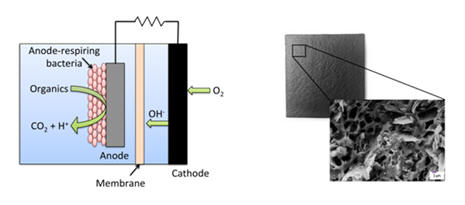New polysiloxanes-based electrode materials for Microbial Fuel Cells (MFCs)
Deep
Two major problems that human beings are now facing are that
of environmental pollution and the energy crisis. MFC represents a technology
that has the potential to address simultaneously both these major problems, as
energy is generated in the form of direct electricity for onsite use during
treatment of wastewaters. Although there has been marked improvement in the
performance of MFC through research, large scale practical application of MFCs
is yet to be achieved. The main constraints for practical application of MFCs
are the high fabrication cost and low energy conversion efficiency.
Hence, to reduce the capital cost of this device, it is necessary to develop
and design economic and cheaper electrode materials which show a comparable
or even better performance. The properties required for the electrodes materials
are different. Anode should be a bio-compatible, conductive, non-reactive material
offering a very high surface area, and should be permeable for the substrate to
avoid kinetic limitations. Similarly cathode material should have catalytic
activity for oxygen reduction apart from higher surface area. Due to an
outstanding collection of properties new electrode materials based on polymer
derived materials are a promising class of new materials.
This project will focus on the development of new electron conducting anode
materials derived from polysiloxanes with high chemical stability, highly
conductive and adjusted porosity and surface characteristics.
Of main interest is optimize the interaction between the biofilm and anode
surface and with this achieve an increased overall performance of a MFC.
Additionally a cathodic support structure with adjusted porosity and surface
structure should be synthesis and tested. The first set of results will be done
by using this inorganic-organic polymer in combination with high conductivity
carbon fillers as starting material that will allow the generation of electron
conducting hybrid materials, which possess a higher chemical stability than
pure carbon materials, high specific surface areas and adjustable surface
characteristics in terms of hydrophilicity or hydrophobicity.
Different compositions (in terms of fillers), dimensions and pyrolysis conditions
should be tested and characterized. Moreover, a fuel cell set-up should be
established that allows measurements with a model solution of bacteria.
Based upon the observations from these experiments, another aim is to address
the scaling up issues of MFC for industrial application. Additionally, cooperation
with Indian partners will provide testing results gain for the new electrodes
materials with MFCs which are operated in a wastewater environment.



